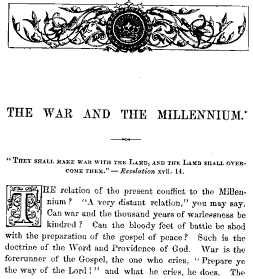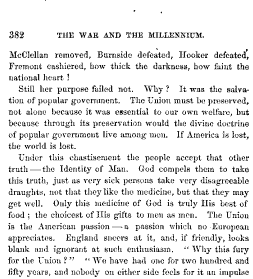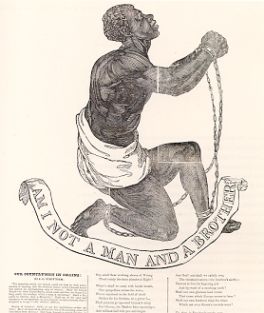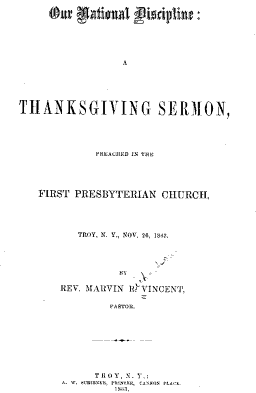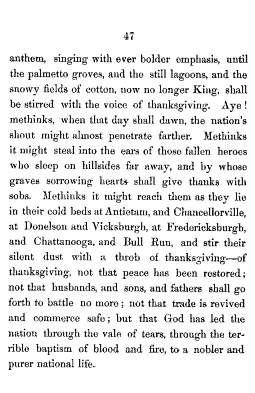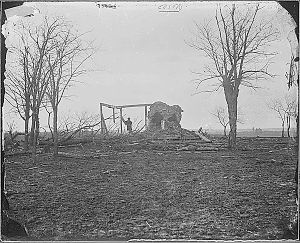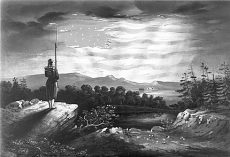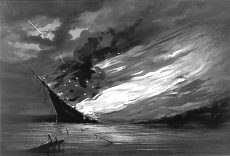from the National Humanities Center |
|
 | |
|
|
| NHC Home |
| Religion in the Civil War: The Northern Perspective | ||
| James Howell Moorhead Princeton Theological Seminary ©National Humanities Center |
| |
After Confederate forces opened fire on Fort Sumter in April 1861, the vast majority of Northern religious bodies—with the exception of the historic "peace" churches which on principle adhered to pacifism—ardently supported the war for the Union. Of these groups, Protestants still enjoyed a significant numerical and cultural dominance in the 1860s. Catholics and Jews provided notable (and heretofore insufficiently researched) support for the war; but Protestants, given their numbers and position in American life, contributed religious or theological justifications of the war that had wider social and political impact. To examine Protestant attitudes in the 1860s is thus to learn much about the popular mood and motivations of Northerners as their "boys" marched off to war. We will look at three of these attitudes of Northern Protestants:
"The Triumph," 1862
Allegory predicting the triumph of the Union over the Confederacy
Freedom, holding the American flag, is flanked by Christianity and Justice, and surrounded by historical figures including Washington, Jefferson, and Franklin. Humanitas reaches down to the manacled slave being restrained by the alligator King Cotton, sovereign of the dark underworld of the Confederacy.
Library of Congress
explanation of allegory
- the special place of America
in world history- a Northern victory as a prelude to the millennium, and
- the issue of slavery.
First, the churches emphasized that the Union had to be preserved because of the special place that America occupied in world history. With its republican institutions, democratic ideals, and Christian values, the United States supposedly stood in the vanguard of civilization's forward march. The success of the Confederate rebellion would imperil that progress. If the South succeeded in dismembering the Union, republican government would be deemed by people everywhere to be a failure. It would no longer appear to be the wave of the future, and the advance of liberty around the globe would be slowed or even halted.
Thus in fighting to maintain the federal union, Northerners were struggling on behalf of more than a single nation—they were contending for the future of humanity itself.
Thus in fighting to maintain the federal union, Northerners were struggling on behalf of more than a single nation—they were contending for the future of humanity itself. Next, Christian ministers often portrayed the war for the Union in millennial terms. Drawing on the imagery of the twentieth chapter of Revelation and on other portions of the Bible describing events near the close of history, they suggested that a Northern victory might prepare the way for the Kingdom of God on earth. (This did not mean that they expected Jesus to return visibly or literally in the near future. Most Northern ministers were postmillennialists—a technical
term designating those who believed that the Second Coming of Jesus would occur after the millennium or the thousand years of earthly bliss foretold in the twentieth chapter of Revelation. In this scheme, no visible return of Jesus could be in the offing since that event, at the earliest, had to be at least a thousand years away.) Yet even if most did not expect an early literal return of Jesus, they did anticipate that current events would lead shortly to a time when God's reign would be more thoroughly established on earth. Thus one Baptist minister, preaching in Philadelphia in 1863, claimed that the defeat of the rebellion would bring a time that the Founding Fathers of the republic "pictured and dreamed about, and prayed for. It will come with blessings, and be greeted with Hallelujahs, it will be the Millennium of political glory, the Sabbath of Liberty, the Jubilee of humanity."
Christian ministers . . . suggested that a Northern victory might prepare the way for the Kingdom of God on earth.
"If America is lost, the world is lost."
"The War and the Millennium"
A Thanksgiving Day sermon, 1863
excerpts
[Note: This is a different Thanksgiving sermon from that quoted in this essay.]
Such rhetoric served to underscore the immense responsibility resting upon the current generation. "If it falters," wrote a leading nondenominational religious paper, "all is lost . . . We shall stand in history as the most beneficent or maleficent of human generations, and as the most faithful or the most false in the eye of God."
"Am I Not a Man and a Brother?"
with poem
"Our Countrymen in Chains!"
by John Greenleaf Whittier 1837
Seal of the Abolition Society of England, this image was widely circulated in antislavery publications in America.
Library of Congress
full text of broadsideFinally, the issue of slavery. The sense that God was decisively at work in the crisis of the Union also profoundly altered the way in which church leaders dealt with the problem of slavery. At the war's outset, Northern churches were far from unanimous in their attitude toward human bondage. A few denounced the practice as a sin and called for immediate emancipation or abolition. At the other extreme, some argued that the Bible treated slavery as a morally legitimate institution. For example, parts of the Old Testament law recognized and regulated slavery. Jesus lived in a world where slavery existed, and he apparently uttered not a single word of censure against it. The letters of the apostle Paul contained explicit commands that slaves be obedient to their masters. Therefore, ran this argument, contemporary Christians had no business condemning as sinful a social arrangement that the Bible itself sanctioned. Most church leaders appear to have fallen somewhere between these extremes. They considered slavery less than ideal and believed that it would eventually be eradicated by slow and peaceful means, but they also abhorred the abolitionists' attack on slaveholders as sinners and their demand for immediate emancipation. Suspicious alike of proslavery and abolitionist positions, they were prepared to await God's providential resolution of the issue.
. . . the conviction grew that God would continue to chastise the North and would not allow it to win the war until it took steps to end slavery. The war convinced increasing numbers of Northerners that Providence was seeking to resolve the matter more swiftly—and violently—than they had expected. At the start of the war, the avowed aim of Northern policy was to save the Union, not to free the slaves; but mixed results on the battlefield prompted a reassessment of goals. Despite notable victories in the western theater of the war, the story in Virginia was very different. There the Union Army of the Potomac stumbled through a succession of defeats. Believing that the hand of God was in every event, Protestant ministers sought a theological explanation for military failure. They drew on a tradition traceable to
Puritan preaching—the jeremiad—to explain the reverses. The jeremiad was a sermon form (named after the Old Testament prophet Jeremiah) that threatened people with judgment unless they renounced their sins; or alternately the jeremiad took some current disaster, interpreted it as a punishment sent by God, and then asked for what sin the penalty had been imposed. The defeat of Union armies seemed to be punishment of this sort, and the conviction grew that God would continue to chastise the North and would not allow it to win the war until it took steps to end slavery. Conversion to this point of view did not take place at an even rate. Some churches were demanding emancipation as early as the fall of 1861 while others were months or even years behind; but whether early or late, religious groups concluded that the war had signaled God's intention that slavery die and that it die now.
"The defeat of Union armies
seemed to be punishment . . ."
Preparing the dead for burial
after the Battle of Fredericksburg, 1862
National Archives
NWDNS-111-B-4817In short, the churches contributed to the radicalizing of the Northern war effort. Believing that God was using the conflict to establish the kingdom of God on earth and that there had to be a reason for the military reverses the Federal armies were experiencing, churches made what had started as a war for the preservation of the Union into a war of liberation.
In short, the churches contributed to the radicalizing of the Northern war effort.
"Without the evolution of the churches' opinions, . . .
it is unlikely that the president could have proceeded as he did."
Abraham Lincoln, c. 1861-1865
Mathew Brady
National Archives
NWDNS-111-BZ-98In this respect, their transformation of opinion paralleled a similar change in the war aims of the Lincoln administration. In 1861 the president declared that his sole purpose was to preserve the Union. By the fall of 1862, he announced his intention to free, on the first day of 1863, slaves in those areas still in rebellion against the government. In 1864 Lincoln stood for reelection on a platform calling for a constitutional amendment everywhere within the United States. Without the evolution of the churches' opinions that served as both support and goad to Lincoln's own transformation, it is unlikely that the president could have proceeded as he did.
On at least three occasions, President Lincoln proclaimed public fast days when he urged Americans to go to their houses of worship, to confess their sins humbly to the Almighty, and to ask God's blessing. These and other less formally designated times of confession provided opportunities for ministers to express the conviction that the war was a baptism of blood.
"through the terrible baptism of blood and fire"
Our National Discipline
A Thanksgiving Sermon, 1863
text of excerpts
[Note: This is a different Thanksgiving sermon from that quoted in this essay.]
The pouring out of blood was cleansing the nation of its sin and preparing it for moral rebirth. That moral rebirth required more than the abolition of slavery; it required citizens to surrender their selfishness and individualism and to subject themselves more unquestioningly to duly constituted authority. A true and worthy American nationality could be born only to the extent that citizens were prepared to sacrifice themselves for it. In perhaps the most notable expression of this belief, the Reverend Horace Bushnell, a leading Congregationalist minister and theologian in Hartford, Connecticut, preached the Sunday after the Union army had been routed at Bull Run in the summer of 1861: "There must be reverses and losses, and times of deep concern. There must be tears in the houses, as well as blood in the fields; the fathers and mothers, the wives and the dear children coming into the woe, to fight in hard bewailings." In short, from a religious perspective, loss and pain were good. If the North won too easy or cheap a victory, its sins would not
"There must be reverses and losses,
and times of deep concern."
Rev. Horace Bushnell, 1861
Ruins of Henry House
First Battle of Bull Run, 1861
Mathew Brady
National Archives
NWDNS-111-B-1575be purged and its citizens' loyalty would not be established. At the start of the war, a few people were supposed to have boasted that all the blood spilled in the contest could be contained in a single thimble or wiped up by a single handkerchief. The clergy told their people that far more blood not only would be shed, it needed to be shed if the war were to attain its God-appointed purpose.
The clergy told their people that far more blood not only would be shed, it needed to be shed if the war were to attain its God-appointed purpose.
"Our Heaven Born Banner"
The rifle and bayonet of the
Union Zouave sentry serve as
the staff of the American flag."Fate of the Rebel Flag"
The flames of the sinking
warship depict the dying
Confederate flag.Patriotic lithographs based on paintings by William Bauly, 1861
Library of Congress
explanation of prints
The blood baptism received a final ritual enactment on April 14, 1865 (Good Friday) when Abraham Lincoln was shot by John Wilkes Booth only five days after Lee's surrender to Grant. Northern ministers were not unmindful of the symbolism. Like the death of Jesus, said the clergy, Lincoln's blood—a token of all the blood shed over four years—purchased new life for the nation. As one group of ministers suggested: "He [Lincoln] has been appointed . . . to be laid as the costliest sacrifice of all upon the altar of the Republic and to cement with his blood the free institutions of this land."
Thus these religious themes had a major impact on the North during the Civil War.
- Belief that America was preparing the way for the kingdom of God on earth helped to inspire the loyalty of both the Union soldiers and those on the home front.
- The conviction that blood needed to be shed in order forthe nation to be reborn undoubtedly stiffened the resolve of bluecoats and civilians alike to endure unprecedented
staggering losses.
"Reconstruction," 1867
Allegory depicting the rebuilding of the
Union, with the figure of Christ saying
"Do to others as you would have others
do to you."
Library of Congress
explanation of allegory- Without the churches' growing conviction that the hand of Providence was indicating the need to end slavery, it is unlikely that the government would eventually have embraced full emancipation as a war aim. In a similar fashion, the Protestant churches appear to have helped sustain, at least for a few brief years after the war, the energy that was devoted to achieving a Reconstruction based on the ideals of the so-called Radical Republicans. This was a Reconstruction in which the vote would supposedly be available (in the language of the Fifteenth Amendment to the United States Constitution) without regard to "race, color, or previous condition of servitude."
Guiding Student Discussion
It is frequently easy to interest students in the Civil War. The level of popular interest is attested by the fact that dozens of new titles on the Civil War appear every year as trade books as well as academic monographs, that magazines dealing solely with the Civil War enjoy a wide readership, and that hundreds if not thousands of re-enactors continue to fight battles such as Gettysburg, Fredericksburg, and Shiloh every year. In his book Confederates in the Attic (1998), Tony Horwitz discusses this phenomenon and even tells the story of a re-enactor who specializes in mimicking the appearance of a dead soldier whose body has become bloated by the first stages of putrefaction! One segue into discussion might be to ask students to reflect on the reasons for such behavior—that is, to ponder the reasons not only for the bizarre behavior of the "bloater" but for the widespread continued interest in the Civil War. The energy, time, and money invested in the Civil War far exceeds that given to other historical topics.
There is, of course, a danger in opening discussion in this fashion. The military story of the war—whether told as heroic romance, as tale of horror, or as a bit of both—quickly usurps attention. Perhaps the tendency to fix attention on the details of battle can be turned into a classroom ally. Most students will have seen at least one movie depicting a Civil War battle. For example, they may well have watched Ted Turner's movie Gettysburg based on Michael Shaara's novel The Killer Angels. The teacher might remind those who have seen Gettysburg of its depiction of Colonel Joshua Lawrence Chamberlain's 20th Maine regiment holding Little Round Top against charge after charge while their comrades dropped around them. What is it that prompted the men to stand fast in face of a sheet of flying lead and then to charge with fixed bayonets when they were out of ammunition and near exhaustion? (Of course, the same point can be made even more graphically from the Southern side by recalling the nearly suicidal character of Pickett's charge.) Ask students to reflect on the reasons that men would be willing to endure such risks.
"What is it that prompted the men
to stand fast in face of a sheet
of flying lead . . . ?"
Wounded soldier in deserted camp
Mathew Brady
National Archives
NWDNS-111-B-250They may point to the soldiers' unwillingness to let down comrades, to appear as cowards to their fellows, or to disgrace their families. After the discussion runs a bit, the teacher might then introduce some of the religious ideas that the men would have received from their churches, their families, or their chaplains. Students should be asked to ponder these as possible motivations for standing fast in time of danger.
Another way of introducing students to the religious dimension of the Yankee cause might be to direct them to the writings of people with whom they may already have passing familiarity. From its famous opening line—"Mine eyes have seen the glory of the coming of the Lord"—to its closing stanza, Julia Ward Howe's "Battle Hymn of the Republic" is filled with religious images suggesting the millennial imagery so prevalent among Northerners during the war [lyrics and audio at www.contemplator.com/folk2/battle.html]. Many of Abraham Lincoln's speeches evoke religious themes]. The Gettysburg Address deals with the notion of "a new birth of freedom" through the shedding of blood [full text at
lcweb.loc.gov/exhibits/gadd]. His Second Inaugural Address, considered by many to be one of the greatest state papers of American history, likewise evokes ideas of God working out his purpose amidst the carnage of the war [full text at
showcase.netins.net/web/creative/lincoln/speeches/inaug2.htm]. A close reading of these relatively short documents provides the teacher with a way of illustrating the prevalence of religious themes during the war.
If we shall suppose that American slavery is one of those offenses which, in the providence of God, must needs come, but which, having continued through His appointed time, He now wills to remove, and that He gives to both North and South this terrible war as the woe due to those by whom the offense came, shall we discern therein any departure from those divine attributes which the believers in a living God always ascribe to Him?
Second Inaugural Address of Abraham Lincoln, March 4, 1865 (excerpt)
full text at http://showcase.netins.net/web/creative/lincoln/speeches/inaug2.htm
Historians Debate
Religion in the Civil War has not been so much debated among historians as it has been ignored. Of the thousands of titles dealing with the Civil War, surprisingly few address the significant role that religion played in framing the issues of the conflict. Fortunately, this neglect has begun to recede. Randall Miller, Harry S. Stout and Charles Reagan Wilson, eds., Religion and the American Civil War (1998) provides an excellent collection of essays illuminating many facets of the subject.
Links to online resources
James Howell Moorhead holds a Ph.D. in Religious Studies from Yale University and is currently Professor of American Church History at Princeton Theological Seminary. He is the author of American Apocalypse: Yankee Protestants and the Civil War, 1860-1869 (1978). He has also written World without End: Mainstream American Protestant Visions of the Last Things, 1880-1925 (1999). He is senior editor of The Journal of Presbyterian History.
Address comments or questions to Professor Moorhead through TeacherServe "Comments and Questions."
TeacherServe Home Page
National Humanities Center Home Page
Revised: October 2000
nationalhumanitiescenter.org

